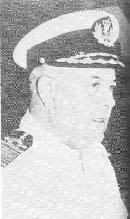Vice-Admiral Conrad Emil Lambert Helfrich


Vice-Admiral Conrad E.L. Helfrich
Conrad Emil Lambert Helfrich was born in Semarang on October 11, 1886 as a son of a Dutch KNIL doctor and a native woman.He had been attracted by the navy all his life and left for Holland on his 17th to become an officer. He passed the four year study at the Naval Institute in Den Helder. After he was sworn in as an officer of the navy, he took part in the Bali-expeditions in 1908 and served on board several warships during his career. He distinguished himself by his intelligence and energy and in 1922 had the chance to study at the High Naval Military School in Holland. He became a teacher there for three years and became chief of staff of the navy in the Netherlands East Indies in 1931. He commanded the NEI squadron in 1935 - 1937 and later became the director of the Higher Naval Military School (Hogere Marine Krijgsschool) and stayed there for about one and a half years.
He was promoted overall commander of all forces in the Netherlands East Indies in October 1939. He was at that time still a Rear-Admiral, but was promoted Vice-Admiral on August 31 1940. He made the impression of a raw seaman, but his conduct was very different. He was a fighter, a good leader and the opposite of a bureaucrat. He was prepared to sacrifice everything in the defence of the Netherlands East Indies, which he saw as an unseperable part of the kingdom, not just as a colony. Not surprisingly, he was against the efforts of the natives for independence. He became friends with Admiral Layton, commander of the China Station and it resulted in an excellent cooperation between the two. During December 1941, he was an advocate of forming a fleet which could attack the enemy where he was vulnerable. He found a brother in arms in Layton, who just as Helfrich, was annoyed by the American movements and actions of the Asiatic Fleet during this period. Helfrich was very aware of the Dutch naval traditions of the past centuries and I believe that was one of the reasons he sent the Striking Force to sea in late February (not meant negatively). After the Striking Force was virtually destroyed and the bases were destroyed, he left the Netherlands East Indies on a Catalina on March 2 1942 and arrived in Colombo, where he quickly set up a new HQ for the surviving ships of this campaign.
He was appointed BSO (Bevelhebber Strijdkrachten Oosten), which was a position that give him control over naval and army forces remaining in the Orient after the fall of the Netherlands East Indies. Especially the Americans were not to thrilled to say the least with Helfrich's decision to send the Striking Force to sea, and it gave him a lot of critisizm. The function BSO was in fact nothing more than a paper function, he had no real control over his ships, and I can imagine he felt side-tracked. Only years later, it was generally understood what the Battle of the Java Sea had meant to the Dutch navy; It had showed its teeth and hadn't run away from a fight. It's the most famous battle of the past centuries.
To go on with Helfrich, he was given command of all naval forces in August 1945 (apparently including the ships in Europe), was promoted to Luitenant-Admiraal (Full Admiral) and was the Dutch government's representative aboard the USS battleship Missouri on September 2 1945. He remained in command until his release from the navy on January 1, 1949. He was awarded "Grootkruis van de Nederlands Leeuw". He wrote his memoires which were published in 1950 and finally passed away in Den Haag, on September 20, 1962.

